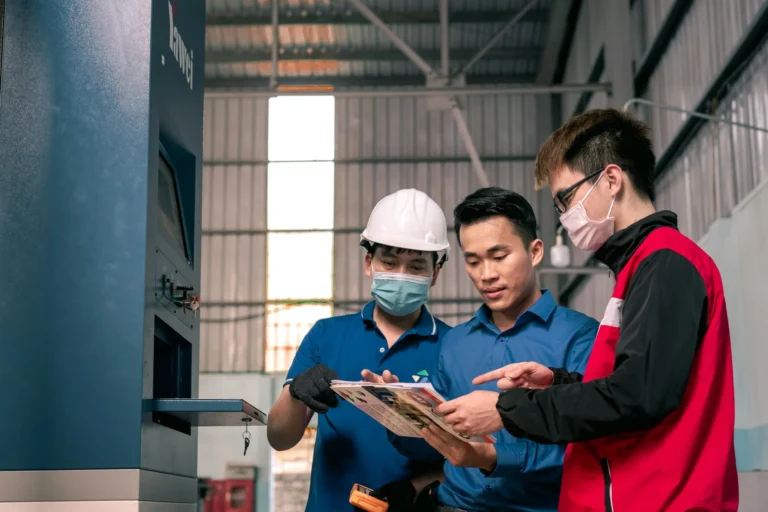The construction industry in Australia has undergone significant transformations in recent years, with technology playing a central role in shaping its evolution. From advanced software solutions to cutting-edge machinery and innovative building materials, technology has revolutionised the way construction projects are planned, executed, and managed. In this blog, we’ll explore the diverse roles that technology plays in modern Australian construction projects, examining its impact on productivity, efficiency, safety, and sustainability.

Building Information Modeling (BIM):
Building Information Modeling (BIM) has transformed the way construction projects are planned, designed, and executed, revolutionising the construction industry worldwide. In Australia, BIM adoption has gained widespread traction, with construction firms recognizing its immense potential to drive efficiency, accuracy, and collaboration throughout the project lifecycle.
At its core, BIM offers a comprehensive digital representation of building projects, allowing stakeholders to create, visualise, and analyse building designs in a virtual environment. BIM software enables architects, engineers, and contractors to collaborate more effectively, breaking down silos and facilitating seamless communication and coordination among project teams. By centralising project data and documentation in a digital platform, BIM ensures that all stakeholders are working from the same information, minimising errors, discrepancies, and misunderstandings.
One of the key advantages of BIM is its ability to visualise project designs in 3D, providing stakeholders with a realistic representation of the final built environment. This immersive visualisation enables architects and designers to explore different design options, assess spatial relationships, and make informed decisions about building layouts, materials, and systems. Engineers can use BIM to analyse structural integrity, mechanical systems, and energy performance, optimising building designs for efficiency and sustainability.
Moreover, BIM facilitates clash detection and coordination, allowing project teams to identify and resolve potential conflicts or errors before construction begins. By integrating architectural, structural, and MEP (mechanical, electrical, plumbing) models, BIM software can automatically detect clashes between building components, such as pipes intersecting with structural elements or ductwork conflicting with architectural features. This proactive approach to clash detection minimises rework, change orders, and delays during construction, saving time and resources for project stakeholders.
In addition to clash detection, BIM enables greater efficiency in project planning and management. Construction firms in Australia leverage BIM technology to streamline project coordination, optimise building designs, and improve construction accuracy. BIM facilitates better decision-making, allowing stakeholders to assess the feasibility and implications of design changes, budget adjustments, and schedule modifications in real time. This proactive approach to project management helps construction firms stay on track with project milestones, minimise risks, and deliver projects on time and within budget.
Furthermore, BIM enhances communication among project stakeholders, fostering collaboration and alignment across different disciplines and phases of the project. By providing a common platform for sharing information, exchanging feedback, and tracking progress, BIM facilitates transparency and accountability throughout the project lifecycle. This improved communication not only strengthens relationships between project teams but also enhances client satisfaction by keeping them informed and engaged in the decision-making process.
Advanced Construction Machinery:
The integration of advanced construction machinery has ushered in a new era of efficiency and precision in the construction industry, reshaping the way projects are executed and managed. In Australia, construction firms have embraced cutting-edge technologies to enhance productivity, safety, and quality on the job site, leveraging a range of innovative tools and equipment to streamline operations and deliver superior results.
One of the key advancements in construction machinery is the use of robotic total stations for surveying and layout tasks. These sophisticated instruments combine the precision of traditional surveying methods with the speed and accuracy of automation, enabling surveyors to rapidly capture detailed measurements and generate accurate site plans. By automating the surveying process, robotic total stations reduce the risk of human error, improve data accuracy, and expedite project setup, allowing construction teams to work more efficiently and confidently.
Autonomous drones have also emerged as valuable tools for site inspection and monitoring in the construction industry. Equipped with high-resolution cameras and advanced imaging technology, drones can capture aerial footage of construction sites, providing project managers with real-time insights into progress, productivity, and safety compliance. By conducting regular drone surveys, construction firms can identify potential issues, monitor site conditions, and optimise resource allocation, enhancing project oversight and decision-making.
Moreover, the adoption of Building Automation Systems (BAS) and Internet of Things (IoT) devices has revolutionised the management of construction equipment and building systems. BAS technology enables real-time monitoring and control of mechanical, electrical, and plumbing (MEP) systems, such as heating, ventilation, air conditioning (HVAC), lighting, and security. By integrating sensors, actuators, and control systems, BAS solutions optimise equipment performance, reduce energy consumption, and enhance occupant comfort and safety.
IoT devices, such as smart sensors and connected devices, offer additional benefits for construction firms by providing valuable data insights and predictive analytics. By collecting and analysing data from equipment, machinery, and building systems, construction firms can identify trends, anticipate maintenance needs, and optimise workflows for greater efficiency and cost savings. For example, IoT-enabled construction equipment can transmit real-time performance data to a centralised platform, allowing project managers to monitor equipment health, track usage patterns, and schedule preventive maintenance proactively.
Overall, the use of advanced construction machinery and technology has revolutionised the construction process in Australia, enabling faster, safer, and more precise project execution. By embracing cutting-edge tools such as robotic total stations, autonomous drones, BAS, and IoT devices, construction firms can enhance productivity, quality, and sustainability on the job site, delivering superior outcomes for clients and stakeholders. As technology continues to evolve, the potential for innovation in construction machinery remains vast, promising even greater advancements in efficiency, safety, and performance in the years to come.
Prefabrication and Modular Construction:
Prefabrication and modular construction techniques are gaining popularity in Australia, driven by their potential to accelerate project timelines, reduce costs, and minimise waste. Advanced manufacturing technologies, such as computer numerical control (CNC) machining and 3D printing, enable the mass production of building components with high precision and quality.
Prefabricated building systems offer greater flexibility and customization options, allowing architects and developers to create unique, architecturally distinctive structures while achieving economies of scale and consistency in quality.
Sustainable Building Materials:
The construction industry in Australia is undergoing a paradigm shift towards sustainability, driven by the urgent need to address environmental concerns and mitigate the impacts of climate change. With a growing emphasis on eco-friendly building materials and practices, construction firms are increasingly prioritising sustainability throughout the project lifecycle, from design and construction to operation and maintenance.
One of the key drivers of sustainability in the construction industry is the adoption of innovative building materials that offer environmentally friendly alternatives to traditional construction materials. Recycled steel, for example, is gaining popularity as a sustainable building material due to its high strength-to-weight ratio and ability to be recycled indefinitely without compromising its properties. By using recycled steel in construction projects, builders can reduce the demand for virgin materials, conserve natural resources, and minimise carbon emissions associated with steel production.
Bamboo is another sustainable building material that has gained traction in Australia’s construction industry. As one of the fastest-growing plants on earth, bamboo is abundant, renewable, and highly durable, making it an ideal alternative to timber for various construction applications. Engineered timber, such as cross-laminated timber (CLT) and laminated veneer lumber (LVL), offers similar benefits, providing a sustainable alternative to traditional timber while sequestering carbon and reducing the carbon footprint of buildings.
Moreover, advancements in green building technologies are driving the development of energy-efficient and environmentally responsible buildings. Solar panels, for example, are widely used to harness renewable energy from the sun, reducing reliance on fossil fuels and lowering greenhouse gas emissions. Energy-efficient insulation materials, such as spray foam insulation and aerogel, help improve thermal performance and reduce heating and cooling costs, enhancing the energy efficiency of buildings and reducing their carbon footprint.
Water-saving fixtures, such as low-flow toilets, faucets, and showerheads, are also integral to sustainable building design, helping to conserve water resources and minimise water consumption in buildings. Additionally, greywater recycling systems and rainwater harvesting systems are increasingly being integrated into building designs to capture and reuse rainwater for non-potable purposes, such as irrigation and toilet flushing, further reducing water demand and promoting water sustainability.
Furthermore, sustainable construction practices, such as passive design strategies, daylighting, and natural ventilation, are essential for creating healthy, comfortable, and environmentally friendly buildings. By optimising building orientation, layout, and envelope design, architects and designers can maximise natural light, minimise heat gain, and reduce the need for artificial lighting and mechanical ventilation, leading to energy savings and improved indoor environmental quality.
Digital Project Management Tools:
Digital project management tools have revolutionised project planning, scheduling, and communication in the construction industry. Cloud-based collaboration platforms, such as Procore and PlanGrid, facilitate real-time collaboration among project teams, enabling seamless communication and document sharing.
Additionally, mobile applications and wearable technology allow workers to access project information, submit reports, and track progress from the field, enhancing efficiency and transparency on construction sites.

Enhanced Safety Measures:
Technology plays a crucial role in improving safety outcomes in Australian construction projects. Wearable sensors, smart helmets, and real-time monitoring systems enable early detection of safety hazards, such as falls, collisions, and overexertion, allowing for prompt intervention and prevention of accidents.
Furthermore, virtual reality (VR) and augmented reality (AR) technologies are being used for safety training and simulation, providing workers with immersive, hands-on experiences that help them develop critical safety skills and awareness.
In conclusion, technology has become an indispensable tool in modern Australian construction projects, driving innovation, efficiency, and sustainability across the industry. From advanced software solutions to state-of-the-art machinery and sustainable building materials, technology is reshaping the way construction projects are planned, executed, and managed.
By embracing emerging technologies and adopting a culture of innovation, construction firms in Australia can stay ahead of the curve, delivering projects more efficiently, safely, and sustainably while meeting the evolving needs of clients and communities. As technology continues to evolve, its role in the construction industry will only grow, leading to further advancements and opportunities for growth and development.
Wunderbuild simplifies construction management, seamlessly integrating into your workflow to boost efficiency and coordination. Whether you’re handling a complex infrastructure project or a simple renovation, Wunderbuild offers the tools you need to keep your projects organised and on track. Experience the difference Wunderbuild can make in your construction management here.




